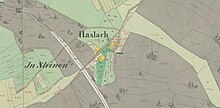Whetstone production (Dornbirn)
The whetstone production in Dornbirn in the state of Vorarlberg in Austria was partly based on naturally occurring raw materials in the Schwarzachtobel (see main article: Whetstone production in the Schwarzachtobel ) and in other districts in Dornbirn (see below) as well as through the production of artificial whetstones.
In Dornbirn, in contrast to Schwarzach, whetstone production was a relatively insignificant branch of production in the municipality.
History and production method
The beginning of whetstone production in Dornbirn from natural raw materials (sandstone) is unknown. In this regard, as in Schwarzach , no reliable findings on manual production have yet been researched. Glauconite - sandstone was in the nearby quarries the Hohenemser plot Klien for centuries for whetstones , Mühl- and paving stones removed and the house building, and then in the plot soil before Dornbirner Gütle ground. In 1585 the following mills were in use in Dornbirn according to a princely account book: the mill, called die Segen (the sawmill after which the settlement Sägen is named), the mills in the Kehlen and in Adelsgehr, the Schnellenmüli am Stiglbach (Haselstauderbach), the lower mill on the Stiglbach, the mills in Völckistobel, in the Ried (the old Riedmühle), on the Dornbirnerach, the lower and the upper mill on the Steinebach , the mill in Schnellen, a saw in the Achmühle, a grinding mill and water hammer without a location and one Schleifmühle am Gießen , a predecessor of the Müllerbach . It has not yet been researched whether this grinding mill without a location or the grinding mill on Gießen was a whetstone loop .
Quartz rock ( Saluiersand from Wildflysch ) was u. a. in Gütle , in the Salzmann parcel, and from there brought to Schwarzach for whetstone production, ground and used as an abrasive (grinding sand) to smooth the surface of the raw whetstones.
In Dornbirn Oberdorf in 1839 Johann Feßler (also: Fässler) received a privilege to produce artificial whetstones. Christian Feßler and Georg Huber ran a whetstone factory for artificial whetstones in the upper Eulental in the middle of the 19th century.
According to the supplement to the Dornbirner Gemeindeblatt (No. 40 from 1883), three whetstone factories for natural raw materials from sandstone were to be found in the Dornbirner municipality:
- Hämmerle Johann and M. Anna in Hatlerdorf , Haslach ;
- Denifl Ludwig, hazel trees ;
- Fuchs Andreas, Schwarzachtobel.
A building application from Johann Hämmerle dated July 2, 1878 for the conversion of a saw into a whetstone grinding shop in a semi-detached house in Haslach in Dornbirn is proof that whetstones should not only be mechanically processed in the Haselstauden district in Dornbirn. This is also the first verifiable mention of a circular whetstone loop in Vorarlberg, although it is not certain whether other sharpening circles had not already existed in Vorarlberg. This whetstone loop was in operation until 1890 and burned down on February 17th.
With the emerging mechanization of agriculture and the increased production of artificial whetstones outside of Vorarlberg, the economic importance of whetstone production in the Schwarzachtobel was also lost in the municipality of Dornbirn after the Second World War.
See also
- whetstone
- Whetstone grinding
- Whetstone production in the imperial county of Hohenems
- Schwarzachtobel whetstone production
literature
- Helmut Keim and Ute Rautenberg. The Unterammergau whetstone making. Open-air museum of the district of Upper Bavaria. Documentation I. Großweil 1987.
- Bruno Koch, On the history of the Schwarzacher whetstone production , Edition Europa Verlag, online publication , accessed on December 10, 2016.
- Bernhard Lehnert: Dengeling. The art of sharpening scythe and sickle. Books on Demand GmbH, Norderstedt 2005, ISBN 3-8334-2586-5 .
Web links
Individual evidence
- ↑ Announcement in the Vorarlberger Volksblatt from Tuesday, August 20, 1878, p. 497: " The whetstone production is gradually gaining in expansion in our community. It is not a long time since we started manufacturing the whetstones as they were already it has existed for a long time in Schwarzach, has been introduced in Haselstauden. Now a circular whetstone loop is being planned at the other end of Dornbirn in Haslach. There is no shortage of material in our extremely rich area and there is no lack of heels, it seems, also not . "
- ↑ The plot of land is about 450 m as the crow flies from the Salzmann district. For many decades there was a power plant on the Boden plot to convert hydropower into electrical energy. Today the night club Conrad Sohm is located there .
- ↑ Franz Goll, Chronicle of the Rhomberg Quarry Hohenems-Unterklien and the rock mining between Dornbirn and Hohenems , p. 7, 205, citing further evidence and sources.
- ↑ In Landeskunde von Vorarlberg by Joseph Bergmann, 1868, p. 6, a whetstone loop in the Steinebach is mentioned (see Google Books ).
- ↑ Alois Niederstätter, Dornbirn Lexikon , search term: trade and commerce in the Middle Ages.
- ^ Johann Jakob Staffler , Tyrol and Vorarlberg, topographical, with historical remarks , p. 70.
- ^ Franz Josef Huber , Harald Rhomberg: On the 200th birthday of the textile entrepreneur Franz Martin Hämmerle in Dornbirner Schriften No. 45, p. 57.
- ↑ Richard Eberle: The industrial history of the Eulental in the 19th century , in: Dornbirner Schriften , contributions to city history, No. 38, Dornbirn 2010, pp. 105 to 113.
- ↑ Bruno Koch, On the history of the Schwarzacher whetstone production , p. 33.
- ↑ Dornbirner Anzeiger, Thursday, July 10, 2014, p. 31; Bruno Koch, On the history of the Schwarzacher whetstone production , p. 48.


